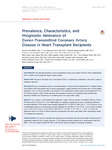Mostrar o rexistro simple do ítem
Prevalence, Characteristics, and Prognostic Relevance of Donor-Transmitted Coronary Artery Disease in Heart Transplant Recipients
| dc.contributor.author | Crespo-Leiro, María Generosa | |
| dc.contributor.author | Couto-Mallón, David | |
| dc.date.accessioned | 2024-01-31T11:33:56Z | |
| dc.date.issued | 2023 | |
| dc.identifier.citation | D. Couto-Mallón, L. Almenar-Bonet, E. Barge-Caballero, et al. Prevalence, characteristics, and prognostic relevance of donor-transmitted coronary artery disease in heart transplant recipients J Am Coll Cardiol, 82 (2023), pp. 753-767 | es_ES |
| dc.identifier.uri | http://hdl.handle.net/2183/35275 | |
| dc.description.abstract | [Abstract] Background The reported prevalence of donor-transmitted coronary artery disease (TCAD) in heart transplantation (HT) is variable, and its prognostic impact remains unclear. Objectives The goal of this study was to characterize TCAD in a contemporary multicentric cohort and to study its prognostic relevance. Methods This was a retrospective study of consecutive patients >18 years old who underwent HT in 11 Spanish centers from 2008 to 2018. Only patients with a coronary angiography (c-angio) within the first 3 months after HT were studied. Significant TCAD (s-TCAD) was defined as any stenosis ≥50% in epicardial coronary arteries, and nonsignificant TCAD (ns-TCAD) as stenosis <50%. Clinical outcomes were assessed by means of Cox regression and competing risks regression. Patients were followed-up for a median period of 6.3 years after c-angio. Results From a cohort of 1,918 patients, 937 underwent c-angio. TCAD was found in 172 patients (18.3%): s-TCAD in 65 (6.9%) and ns-TCAD in 107 (11.4%). Multivariable Cox regression analysis did not show a statistically significant association between s-TCAD and all-cause mortality (adjusted HR: 1.44; 95% CI: 0.89-2.35; P = 0.141); however, it was an independent predictor of cardiovascular mortality (adjusted HR: 2.25; 95% CI: 1.20-4.19; P = 0.011) and the combined event cardiovascular death or nonfatal MACE (adjusted HR: 2.42; 95% CI: 1.52-3.85; P < 0.001). No statistically significant impact of ns-TCAD on clinical outcomes was detected. The results were similar when reassessed by means of competing risks regression. Conclusions TCAD was not associated with reduced survival in patients alive and well enough to undergo post-HT angiography within the first 3 months; however, s-TCAD patients showed increased risk of cardiovascular death and MACE. | es_ES |
| dc.language.iso | eng | es_ES |
| dc.publisher | Elsevier | es_ES |
| dc.relation.uri | https://doi.org/10.1016/j.jacc.2023.06.016 | es_ES |
| dc.rights | © 2023 by the American College of Cardiology Foundation. | es_ES |
| dc.subject | Donor coronary artery disease | es_ES |
| dc.subject | Donor selection | es_ES |
| dc.subject | Heart transplantation | es_ES |
| dc.subject | Transplant survival | es_ES |
| dc.title | Prevalence, Characteristics, and Prognostic Relevance of Donor-Transmitted Coronary Artery Disease in Heart Transplant Recipients | es_ES |
| dc.type | info:eu-repo/semantics/article | es_ES |
| dc.rights.access | info:eu-repo/semantics/embargoedAccess | es_ES |
| dc.date.embargoEndDate | 9999-99-99 | es_ES |
| dc.date.embargoLift | 10007-06-07 | |
| UDC.journalTitle | Journal of the American College of Cardiology | es_ES |
| UDC.volume | 82 | es_ES |
| UDC.issue | 9 | es_ES |
| UDC.startPage | 753 | es_ES |
| UDC.endPage | 767 | es_ES |
Ficheiros no ítem
Este ítem aparece na(s) seguinte(s) colección(s)
-
GI- GRINCAR - Artigos [226]






